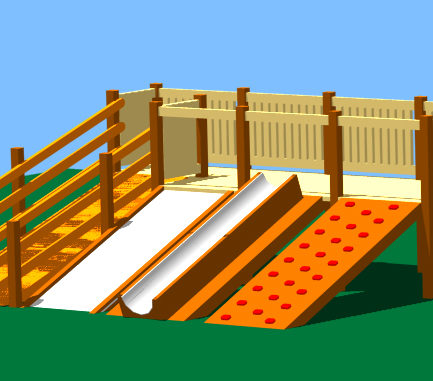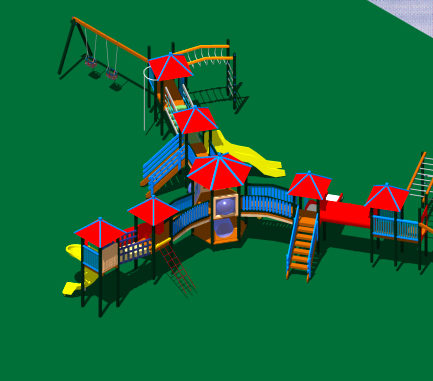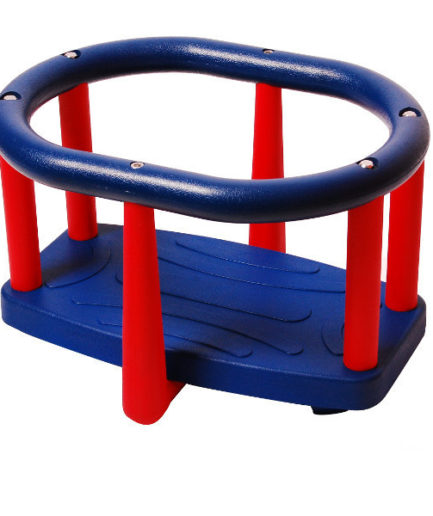TECHNICAL DESCRIPTION
OF A COMPOSITE STRUCTURE
The overall dimensions of the composite structure are 663Χ210 cm by 494 high and it comprises:
2 square decks 162 cm height without roof
1 wavy slide 162 cm
Safety panels in castle form
2 protective handgrips
Plugs for turnbacks
Embedding bases
2 metal balconies
1 staircase 162 cm high
3 pillars of flag
Square tower 162 cm high without roof.
The tower is overall dimensioned 111,5X111,5X394cm and it comprises of:
4 wooden pillars dimensioned 9Χ9 cm. and 354cm high.
1 pieces of plywood Wireness (antislip) whose the upper side is covered with dark brown antislip surface. The dimensions of each piece are 99X99 cm. and the thickness is 21mm. as the decks floor.
Ladder for square deck 162
The ladder for square deck 162 has dimensions roughly 93×232 cm and projection length from the deck roughly 166 cm. It is constituted by:
2 pieces of wood of dimensions 4.5x20x232 cm
7 pieces of wood of dimensions 4.5x20x88 cm
7 pieces of wood of dimensions 4.5x6x84.5 cm
2 pieces of wood of dimensions 9x9x90 cm
Between the two pieces of wood 20×232 cm are placed the 7 pieces 4.5x6x84.5 cm every 20 cm. On them applied the 7 pieces 4.5x20x88 cm as steps. On pieces 20×232 cm are screwed vertical the pieces 9x9x90 cm, one on each side. Between the woods 20×232 cm and the vertical 9x9x90 cm the parallelogram void on each side is covered with plywood.
Wavy Straight Slide for Deck 162 cm.
The wave straight line slide chute is 162 cm high. It is made with the method of the rotary infusion, being moulded within forming dies. It is moulded by linear, low density polyethylene with stabilizers against the ultra violet radiation and providing antistatic (of static electricity) protection.
The paint to be applied each time, which is non-acid, is added with the rotary infusion of the forming dies. It is in one-piece and is also fitted with a one-piece protection cover made of the same material, to avoid any falls. Such materials comply with:
ASTM – D – 790 Flex Modulus
ASTM – D – 638 Tensile Strength
ASTM – D – 648 Heat Distortion Temperature
ARM – STD Low Temperature Impact
The diameter of the panels must be at least 6 mm thick.
Exceptions, if any, must be stated.
ASTM = the American Society for Testing and Material
The American Materials Testing Service.
SAFETY TYPE HANDGRIPS
The safety type handgrips are metallic, of electrostatic dyeing, of vertical lining up, two in a row, with the inner one being bent on the top side. It is provided with a metallic support blade on its lower part and a support point on the upper part. They are made of pipe Ø 32 mm. 80 cm high, and tolerances are provided between them in conformity with ΕΝ 1176. After they are processed for their degreasing, they are coated with polyzinc and then they are subjected to electrostatic dyeing with powder.
The handgrips of safety type are fitted at those points of the lofts in which no entrance/exit protective panels, rails etc are fitted
SAFETY PANELS IN CASTLE FORM
Safety panels are manufactured by colourful plywood and being placed in the exterior sides of structural elements of manufacture (decks etc). They are used for the safety and protection of users in the manufacture and at the same time it allows the optical control of children from their parents. The openings that allocate are completely harmonised with model EN 1176 for the safety from entrapment. They have engraved in their exterior side the representation of stone wall of castles and is used different piece for the creation in the above part of manufacture.
METAL BALCONIES
The balcony that is used in Castle 2T-162 is manufactured from metal and has total dimensions 93,5x50x108 cm. It has semicircle form and it is constituted by the following main parts:
The Base with Metallic frame
The Metallic Floor
19 Metallic Handrails
The Metal Railing
The metal skeleton of balconys base is manufactured by pipe of cross-section Ø32 mm, which is galvanized and then electrostatic dyed. It consists of a bended pipe in a form of a semicircle.
For the balconys metal floor is used sheet-metal galvanized and electrostatic dyed, with total dimensions 109,5×66 cm and thickness of 4 mm, which bended 8 cm each side and then is cut so that it takes the desirable form. When the process of manufacture is completed, the floor is being welded on the metal skeleton with suitable method of thermo weld. On the bended side that deck is linked with the balcony and in same distance, exist holes of diameter Ø 5/8 ”. In this holes are applied screws 5/8” X 15 mm in order that the union between deck and balcony is completely secured.
Metal handrails of the balcony are manufactured by galvanized and electrostatic dyed pipe of cross-section Ø 11 mm and height 96,8 cm and they placed in spaces according the EN 1176. Handrails are been welded on the surface of floor with the method of thermo welding.
Metal railing of the balcony it is manufactured with the same precisely way with the base of the floor, with one differentiation. On the two utmost semicircles, they are placed metal laminas of dimensions 8×4 cm and thickness of 4 mm under form “Γ”. Above the two corner sides of this laminas exist holes of diameter D=10 mm roughly, from which go through screws of same diameter. This laminas are applied and screwed in the two vertical decks beams where the balcony will be placed, ensuring support of balcony.
Before railing screwed in decks beams, is being welded on the upper part of handrails, giving a protective railing of height of 1 m for the absolute safety of children that will use the balcony.
TIMBER
The wood which is used for the equipments is a composite non-stick wood of pine tree, Swedish type, in conformity with ΕΝ 351. It is made with a special union (welding of woods) at various cross sections, depending on the use it is intended for.
The COMPOSITE WOOD is by 40% more powerful than the wholesome wood. Its strength is 360 kp/m2 and its special weight is around 480 kg/m3.
▪ It contains approximately 15% humidity
▪It contains minimum juices (resin) as compared with the other trees of the family of pine tree of the other countries (weather conditions in the Northern Sweden up to -25 ο )
▪Its thermal conductivity is s=0,10 Kcal/Mho and its sound insulation is 3.5 times higher than that of the concrete or brickwork of equal thickness.
▪It has anti-magnetic qualities and it is non-conductor of the electric current.
▪It is resistant to fire and it ranks in the classes of F30 and F60 (as per DIN 4120) depending on its cross section.
▪When the outer part of the cross section is burned, the inner part is protected and retains its strength.
▪ It can be processed in the same way as the wood which is sold in the market.
▪It maintains its form and is hard to deform or to crack.
▪The annual rings of the wood are usually vertical to their big side with a significant increase of the mechanical strength of this surface, should it be applied on floors.
All the angles (edges) of woods are shaved in the radial sense 5 mm. at least.
PLYWOOD
The plywood-made parts, which are required for our structures are at least 17 mm thick and are made of wood sheets each 1,5 mm thick, being welded between each other, by way of thermo-welding process under pressure, using resins of phenol base, non-toxic. They are dyed with water-dissoluble paints, in which no sealing compounds have been added, nor any diluting items or dyes, which contain lead, chrome, cadmium or other heavy duty metals. The paints also offer high resistance under adverse weather conditions.
The above sheets of plywood are in conformity with standards ΕΝ 314-2.
The quality of the plywood is such that no further processing is required prior to the dyeing process, such as application of putty.
PLASTIC ELEMENTS
The plastic elements that are required for the manufacture of equipment are highly resistant to the ultra violet radiation and in unfavourable weather conditions. The preferred materials are those which can be recycled such as the polyethylene (ΡΕ) or the polypropylene (ΡΡ). In particular, all the bolts, which stand out of the equipment by more than 5 mm, are covered with plastic plugs of polypropylene (ΡΡ). Also, they are harmless for the safety and the health of the children.
METAL ELEMENTS
The metal elements that are used for the manufacture of equipment (screws, contacts etc) are manufactured from thermo-galvanised steel (with zinc), electro-galvanised, in which the surface has been previously prepared with sandblast or stainless (stainless steel). The dimensions and the cross sections of the metallic elements are sufficient to accommodate (with the suitable safety coefficient) the loads for which they have been studied to resist corrosion and adverse weather conditions.
PAINTS
The varnishes and the paints with which the wooden parts are protected, have been specifically studied for the climatic conditions of our country (temperature changes, open or closed spaces etc), are entirely harmless for the users (they contain no lead, chrome or cadmium or any other heavy metals) and they give a high resistance in our structures. |
|






